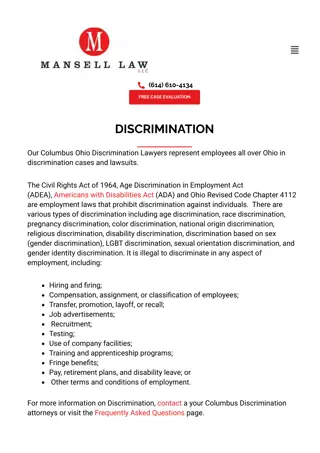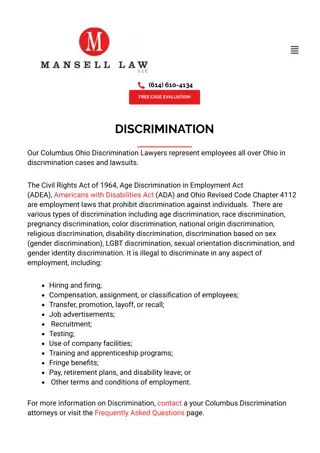Understanding Discrimination Power in Testing
Discrimination power in testing refers to an item's ability to differentiate between high and low-performing students. By analyzing test results and calculating discrimination indices, educators can enhance the quality of test items and better identify students' strengths and weaknesses. The process involves collecting and analyzing data to determine how effectively items distinguish between student performance levels. This aids in creating fair and effective assessments that support student learning and academic growth.
Download Presentation

Please find below an Image/Link to download the presentation.
The content on the website is provided AS IS for your information and personal use only. It may not be sold, licensed, or shared on other websites without obtaining consent from the author. Download presentation by click this link. If you encounter any issues during the download, it is possible that the publisher has removed the file from their server.
E N D
Presentation Transcript
What is Discrimination power? The word Discrimination means: Recognition and understanding of the difference between one thing and another The ability to judge what is of high quality; good judgement or taste
Discrimination Power The Discrimination Power of a test item is its ability to differentiate between good (H) and poor (L) students.
Purposes Helps to check and improve the quality of items Distinguish between good and weak students Helps in preparing best test items
The process for determining item discrimination index is to subtract the proportion of correct responses in the low scoring group from that of the high scoring group. We can express it in a formula as :
Before going to the formula first we need to collect data required for the formula. We need to make Analysis working sheet as we prepare in item analysis.
Making item analysis worksheet First score the test Then arrange the test papers in descending order on the basis of marks (highest score to lowest score) Select about one forth of the papers from highest scores and one forth from lowest scores.
Making item analysis worksheet Now draw a table and write each item number and its response for each student in the form of correct (1) and wrong (0).
Total Number of Students (N): 10 Number of questions/items = 5 1 = Correct response/answer 0 = Wrong response/answer High-scoring group (H) Low-scoring group (L) Item No. AA AB AC AD AE BA BB BC BD BE 1 1 1 1 1 1 1 1 1 1 1 2 1 1 1 1 0 1 1 0 0 0 3 0 1 0 1 1 1 1 0 0 0 4 1 1 0 0 1 0 1 0 0 0 5 1 1 1 1 1 0 0 0 0 0
Now count the number of right responses in highest scoring group (H) and lowest scoring group (L) for each item. Now subtract L from H.
(Data of table 1 organized for computing item difficulty and item discrimination) H= Number of students in the high-scoring group who got the item right. L= Number of students in the low-scoring group who got the item right. Item No. 1 H L H-L 5 5 0 2 4 2 2 3 3 2 1 4 3 1 2 5 5 0 5
Discrimination Index Formula ? ? ? 2 D = index of Determination H = number of students in higher-scoring group who answered correct. L = number of students in low-scoring group who answered correct. N = Total number of students in both high and low scoring group. ? =
Now we can determine the Discrimination power of any item by this formula. For example: The D value for each item will be :
Item 1 Item 2 Item 3 Item 5 item 4 ? ? ?? 2 3 ? ?? 2 3 1 ?? 2 5 5 ?? 2 5 0 ?? 2 ? = ? = ? = ? = ? = 0 ? ? ? 1 ? ? ? 5 ? ? = ? = ? = ? = ? = ? = ? ? = ?.? ? = ?.2 ? = ?.? ? = 1
The index of item discrimination (D) vary from +1.00 through 0.00 to -1.00. The maximum size of D is +1.00 The minimum size of D is -1.00 The D will be zero when from high or low group answers the item correctly or all of them answers correctly.
What is a good value? Number of Students achieving each Score 30 20 10 0 0 10 20 30 40 50 60 70 80 90 100 Hard Exam Normal Exam Easy Exam For exams with a normal distribution, a discrimination of 0.3 and above is good; 0.6 and above is very good. Values close to 0 mean that most students performed the same on an item. The index should never be negative.
Another consideration for D 0.40 and greater are very good 0.30 to .39 are reasonably good 0.20 to .29 are marginal items and need some revision, 0.19 and below are considered poor items
The larger the D value the better the item will be. For the purpose of classroom testing we can accept an item whose D value is not below +0.20























